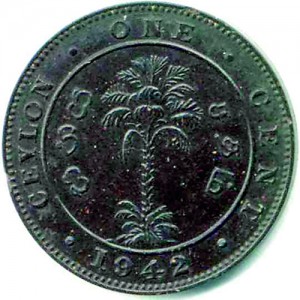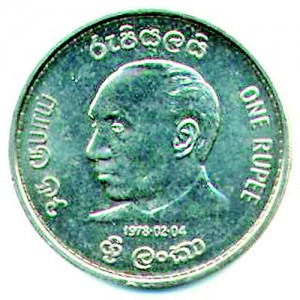So you found some old currency…
As a collector, with an educational Internet website on coins on Lanka, I frequently get questions about the value of coins in people’s possession. A few weeks ago I got an unusual question, which read:
Dear sir,
On a casual day there were a few people in our neighbourhood willing to pay Lankan rupees 5000 for pre independence one cent coins. Please enlighten me on this subject. Please also inform me where I can sell them. My mother-in-law happened to possess five of these coins and has been literally drooling over such a prospect. Your expertise and advice on this subject would be of immense value.
Thanking you
K
I had heard this story a few months before, but did not pay any attention to it. Circulated pre-independence copper one cent coins sell for less than Rs.25. I confirmed with my trusted dealer that those people only agree to pay Rs. 5000 for a one cent coin of a year in which none were issued.
Analysis of the ingenious scam
In a nutshell a dealer offers a large sum of money for non-existent coins or banknotes. Since the public don’t know that such an item does not exist, it motivates them to bring out their old currency for sale. The dealers go through them and say that the specific rare item is not there. If there is any item of value, they offer well below market value for them. Disappointed you sell without checking, to get something for your effort. At the same time the dealers also sell at much above market value similar currency to ignorant buyers who think they can resell for a higher price.
The only rare pre-independence one cent coin worth any significant value is a pattern struck in Black Bakelite which was never put into circulation.Due to a wartime shortage of copper, a pattern in Bakelite was manufactured by a private firm and sent to Ceylon for evaluation. This was not viewed kindly by the Royal Mint which took action against the firm. This pattern was not seen to be durable for circulation. In September 1942, a bronze coin of half the original weight was adopted for circulation. Only few of the Bakelite coins are known. The only recorded sale in Auction was in 1994 for US$440. See http://coins.lakdiva.org/pattern/1942_george_vi_01c_pattern.html
A few years ago one scammer advertised in a popular Sinhala newspaper offering to pay Rs. 7 lakhs for a Queen Elizabeth one rupee Banknote of 1940. Princess Elizabeth only became Queen in 1952! When I complained to the editor that they were being used to propagate a fraud, he explained that it was impossible for them to verify the authenticity of every commercial advertisement.
The scammer even altered the date on a 1954 note and passed around photo-copies. This was a successful campaign and they probably sold a lot of similar notes, at much above market value to ignorant buyers. Dealers informed me that the sudden interest caused a significant increase in the price of wartime banknotes.
The Central Bank itself tried a similar way to get people to bring change back into circulation. In addition to giving the face value, participants got Rs. 20- more for every 100 coins. CBSL also offered a special reward for an unnamed rare coin.
 The only rare circulation coin is the “right shoulder straight” version of the JR one Rupee coin. The rush order of 2600 coins brought in time for the inauguration on 1978-02-04 was later found to have been struck from a significantly different die to the rest of the 2 million coins minted. The probability of finding one of these rare coins among circulated JR coins is less than one in 750, as most of the first issue was kept as souvenirs and did not go into circulation. It is worth more than US$50. See http://coins.lakdiva.org/commemorative/1978_jr_1r_rss.html
The only rare circulation coin is the “right shoulder straight” version of the JR one Rupee coin. The rush order of 2600 coins brought in time for the inauguration on 1978-02-04 was later found to have been struck from a significantly different die to the rest of the 2 million coins minted. The probability of finding one of these rare coins among circulated JR coins is less than one in 750, as most of the first issue was kept as souvenirs and did not go into circulation. It is worth more than US$50. See http://coins.lakdiva.org/commemorative/1978_jr_1r_rss.html
Adding support to these scams are certain free internet sale sites. Unlike eBay.com which started back in 1995, and has a mature market place for numismatic items, the newer sites are trying to attract sellers by giving free listings. Unfortunately this has resulted in many in Sri Lanka,listing coins for sale at totally unrealistic prices. Common 11th century Massa or 16th century VOC Duits, which wholesale for under Rs100, are listed for over Rs one lakh each.
Many of the items listed on these Internet websites are older than 100 years and it is illegal to take them out of the Sri Lanka, because of Antiquity Laws. I am not sure why the Cybercrime division of the Sri Lanka Police in collaboration with the Archaeological Department is not taking action to stop these illegal sales.
| Local market value
Most web surfers who stumble upon these Internet auctions get excited that they may possess items of high value. Some list them on the site and probably wonder why no one is buying. A reasonable way of estimating value online is to search eBay.com selecting “Sold listings”option. However note that because of the Antiquity Laws, prices abroad could be slightly higher than prices in local market. There are Standard Catalogues of World Coins and Paper Money published by Krause Publications of USA which give current market values of coins minted after 1600 CE and Banknotes after 1368 CE. An uncirculated coin or banknote could be 10 times more valuable, than one which is well circulated. In general coins should never be cleaned except with soap and water. Some ancient coins may require conservation, but that should only be done with expert knowledge. Banknotes should never be washed or ironed to make them look better. These actions can easily be detected and will reduce the value of the numismatic item. When you find some old currency among your late relatives’ belongings you need a knowledgeable evaluation of local market value, before you plan that dream vacation, you could not otherwise afford. |



